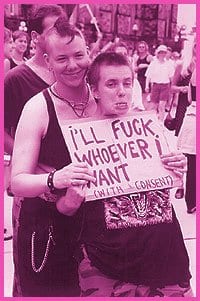From its humble beginnings in the late ’80s to a full-blown organization of conflicting visionaries with a wild disregard for accumulation of debt, the history of Ottawa’s Pride committee and festival has almost always been a tale of celebratory triumph over business inefficiency and political obstacles.
Now facing a staggering debt of $48,000 to creditors, some in the community remain uncertain how Pride 2003 will proceed, although interim chair Robin Duettais confident that there will be a festival and that issues between beggar and lender will be resolved.
“Creditors are waiting pat-iently for their money,” he says.
Despite mounting financial strains and constantly changing committees, Ottawa’s Pride festivals have grown steadily since the first parade on Bank St on a wet day in 1989. Roughly 300 people turned out for the week-long activities, which included dances, exhibits, films, sports events and receptions. That year, Mayor Jim Durrell even proclaimed Equality Day.
At that time, there was no official organization for Ottawa’s Pride week. In the wake of the 1991 murder of a man suspected of being gay by a group of homophobic thugs, the need for such an organization was given added weight by the GLBT community’s defiance.
From there, the chronology of Ottawa’s infamous Pride Week and its surrounding tantrums only gets better.
1992
Initially, the City of Ottawa passes a Pride Day proclamation in a 9-6 vote. However, a reconsideration vote is called when an alderman points out that the event is taking place on Father’s Day.
After a two-hour debate, where Mayor Jim Durrell cited “Pink Power” special interests as his reason for voting against the proclamation, they rescind it, 8-6. Ontario Supreme Court Justice Allan Austin saves the day, calling the city’s decision discriminatory and ordering the proclamation reinstated. The media love it and almost outnumber the 350 Elgin St marchers they were covering.
1993
Alex Munter is the fifth publicly elected official in Canada to come out. The provincial NDP fails to pass its same-sex marriage rights bill, and Ottawa’s little parade hits the 1,000 mark.
1994
The number of marchers doubles to 2,000 – but it doesn’t help the books, as the Pride Committee is left witha $700 deficit.
1995
Controversy dogs the parade as internal and external arguments become fierce. Four organizing members of the Pride Committee under chair Bill Hunter leave – either voluntarily or by force, depending on whose account you hear.
City Council decides to reword the Pride proclamation, changing “bisexual and transgendered” to “alternative lifestyle communities.”
A native protest on Victoria Island forces a last-minute site move, to the park next to the Supreme Court. The controversy doesn’t seem to stop people from coming out, and 3,000 people participate in the first march on Parliament Hill. The committee is left with a $3,000 deficit.
1996
Five thousand take partas a new guard takes controlof the Pride Committee and works to move the Pride finances into the black. The committee expands the scale of Pride by marketing to community and media groups outside the city. Festivities wrap up with a $16,000 surplus. Yvon Vaillant is acting chair.
1997
Ottawa Mayor Jacqueline Holzman refuses to proclaim Pride Week, citing the ongoing human rights case from proclaiming “alternative lifestyle communities” in 1995. The case is finally settled with Holzman offering an apology as council proclaims Pride.
Regional headquarters flies the Rainbow Flag to mark the day. The parade route returns to Bank St in recognition of the growing number of gay businesses. Despite some organizational chaos, 8,000 people take part. A children’s area is added. The usual anti-gay Christian protesters are overshadowed when the United Church and the Unitarian faith join the parade. A $20,000 surplus is achieved. Yvon Vaillant remains as acting chair.
1998
Prime Minister Jean Chretien sends best wishes for Pride events across the country. Flags are set to fly at municipal buildings. Proclamations are made by the city and region with minimal fuss. Pride Committee Chair Yvon Vaillant promises bigger and better, with a plea to the community to help him reach the goal of 15,000 people.
Ten thousand show up. Vaillant also uses the festival to raise funds for the loss of trees during the ice storm and resigns as chair. There is a $5,000 surplus.
1999
Marion Steele (a former vice-chair) is now chair. Twenty thousand people attend – another record-breaker. Sixty-two community groups and 27 floats are involved in the parade, which leaves an $8,000 surplus. Bitter infighting and threats of legal action involving Vaillant sour relations within the committee, and Steele does not seek re-election. Cecil Turcotte assumes the role of chair.
2000
A rainy-day parade draws only 8,000 people, including 55 groups consisting of 350 participants. Committee faces accusations of disorganization and lack of coordination. The books are left to be balanced and conflicting statements regarding the committee’s finances are made. Peter Bishop assumes role of chair for the 2001 festival.
2001
Fifteen thousand people march in the Pride parade. Bishop expresses uncertainty about the community’s solidarity over Pride. Left over isa $10,000 deficit.
2002
Jarmila Dokladova assumes the role of chair, and this particular Pride festival claims to have drawn an extraordinary 100,000 people over the week long festivities, 55,000 of them attending the Street party along Bank St. Unfortunately, a deficit of nearly $50,000 is accumulated. Ghislain Rousseau steps in as chair.
2003
After months of dealing with unpaid creditors, community groups’ frustration and legal threats, the board resigns in March. Rousseau reiterates Yvon Vaillant’s earlier call that a paid managerial position be secured to aid the committee volunteers.
Robin Duetta becomes interim chair to assess the committee’s future.

 Why you can trust Xtra
Why you can trust Xtra


